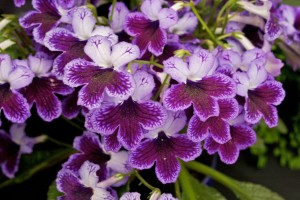
“Streptocarpus” is an awful plant name, suggestive of sore throats and other maladies that can only be cured by antibiotics. In reality, if a plant lover is infected with a yen for streptocarpus, the malady may prove to be long-lasting and pleasant.
Streptocarpus is commonly known as “Cape primrose”, a much better name that invokes images of faraway places and dainty spring flowers. The sight of those flowers will not inflame the tonsils, but might help cure the cankered soul, especially during the dark winter months.
I have had intermittent streptocarpus lust for years, inflamed from time to time by catalog pictures and houseplant reference sources. The plants are beautiful, growing 12 to 18 inches tall and wide, with basal rosettes of soft, round to elongated foliage that tends to be wrinkled in appearance. The flowers are borne above those leaves on relatively short stems. Each one is composed of an elongated tube that flares out into five petals, which are sometimes frilled on the edges. Many of the fancier streptocarpus feature petal arrays that are almost iris-like with two upper petals and three lower petals. The blooms may be tinted white, yellow, pink, red, blue-purple, purple or bi-colored. Sometimes the petals are also marked with contrasting throats, dots or “whiskers” reminiscent of pansies or even orchids. A mature plant will bear many flowers at a time and bloom repeatedly over the course of a year.
The “Cape” in the common name refers to South Africa, home to the ancestors of today’s hybrid Cape primroses. The “primrose” part has little to do with the common primroses that most of us grow in our spring gardens. It was probably just a reference to the delicate appearance of the flowers, and/or the lettuce-like leaf configuration, which resembles the basal rosettes of primrose family members.
The streptocarpus genus is part of the large Gesneriaceae or African violet family and the plants have many of the recognizable African violet traits—including the range of flower colors, care requirements and light preferences. Some people find Cape primroses easier to grow, but I think both require similar amounts of care and attention and offer the same levels of gratification.
It takes many species to make a modern outdoor or indoor ornamental plant. The showy Cape primroses that are starting to appear in nurseries and garden centers now were bred from species like Streptocarpus primulifolius, introduced from South Africa to Europe in 1826, and Streptocarpus dunnii, which made it to Europe in 1886. The latter was a red-flowered species that got breeders at England’s Kew gardens excited and most likely helped them widen the available range of flower colors. In the twentieth century, two English horticultural firms, Veitch and John Innes, made wide inroads in breeding, including irradiation of plants to produce even more colors. Breeders also developed compact varieties that can be grown in three or four-inch pots.
Online nurseries offer a vast array of streptocarpus. I especially love the flamboyant ‘Harlequin Lace’, with pale blue and white upper petals and lower petals adorned with a lacey combination of darkest purple and white. If you prefer something a little simpler, you might try ‘Heartland’s Snow Crystal”, which boasts large, pure white flowers.
When you receive your primrose in the mail from a specialty vendor or bring it home from a nursery, inspect for pests or signs of disease. Providing there are none, place in the bright, indirect light provided by a north, east or west-facing window. Refrain from killing your Cape primrose with the kindness of giving it too much water. Water only when the top of the soil looks and feels dry, and avoid splashing leaves, as it causes unattractive spotting. I use slow-release plant food stakes, which eliminates the need to remember regular feeding, but you can also use liquid or granular products according to package directions.
Beyond those minimal maintenance functions, all you really have to do is deadhead the spent flowers and remove any dying leaves from the plant. Plants will sometimes go dormant after they flower. If this is the case, don’t despair, just water minimally and stop feeding. In a month or two, the plant will revive and start its growth cycle again.
Like the evil streptococcus bacteria, streptocarpus plants can be quite contagious.
If you are itching to catch the streptocarpus bug, visit any large nursery or garden center. If their supplies are lacking, go to Logee’s Greenhouses, 141 North Street, Danielson, CT 06239, (888) 330-8038, www.logees.com. Another wonderful supplier is Violet Barn, PO Box 9, Naples, NY 14512; (585) 374-8592; www.violetbarn.com.
